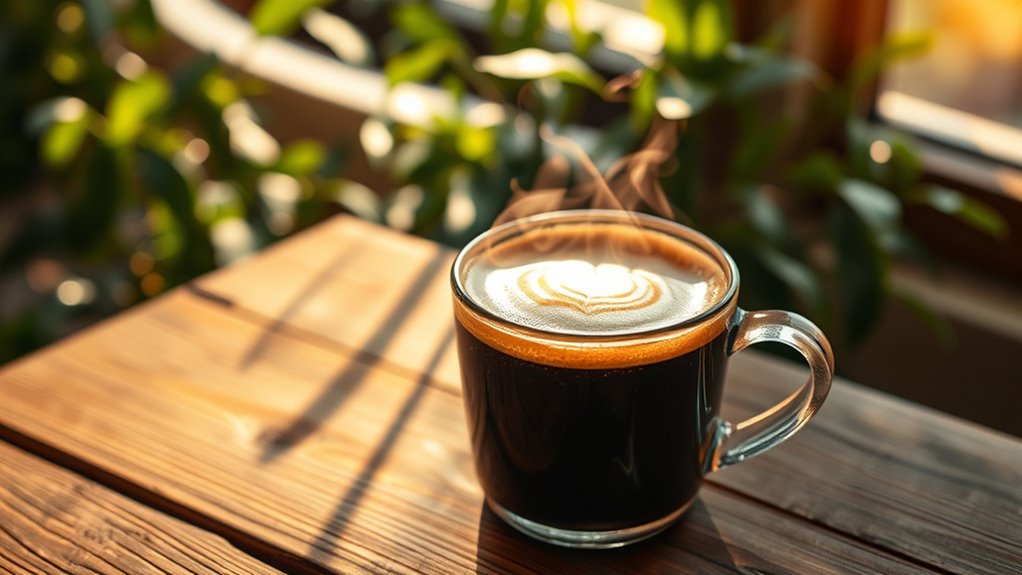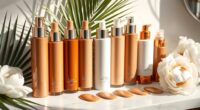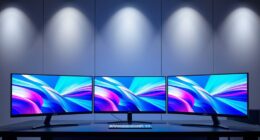To enjoy your coffee to the fullest, aim for a brewing temperature between 195°F and 205°F. This range is crucial for extracting the best flavors and aromas. Light roasts perform best at around 205°F, while dark roasts should be brewed closer to 195°F to avoid bitterness. After brewing, enjoy your coffee at a drinking temperature between 125°F and 155°F to experience its rich flavors. There's more to explore about achieving the perfect brew!
Key Takeaways
- Brew coffee at temperatures between 195°F and 205°F for optimal extraction and flavor balance.
- Light roasts thrive at 205°F, while dark roasts should be brewed around 195°F to avoid bitterness.
- Serve coffee at drinking temperatures of 125°F to 155°F for the best flavor experience without burning the tongue.
- As coffee cools, it enhances sweetness and acidity while reducing bitterness, enriching taste complexity.
- Experiment with grind size and coffee-to-water ratio to tailor the flavor to personal preferences.
Understanding Brewing Temperature

When brewing coffee, understanding the right temperature is crucial to achieving the perfect cup. The ideal water temperature ranges from 195°F to 205°F. If your water's too hot, above 205°F, you'll risk over-extraction, resulting in a bitter taste. Conversely, water below 195°F can lead to under-extraction, making your coffee sour or weak. Additionally, using fresh ingredients in your coffee blends can enhance flavor just as it does in homemade juices.
Understanding the right water temperature is key to brewing the perfect cup of coffee, ideally between 195°F and 205°F.
Keep in mind that factors like roast type and bean variety can influence your temperature needs. Lighter roasts may need slightly higher temperatures, while darker ones benefit from lower heat. Additionally, using coarsely ground coffee can help optimize extraction in methods like the French press.
Using tools like thermometers and adjustable kettles can help you maintain that ideal brewing temperature, ensuring each cup is consistently delicious, regardless of your brewing method or elevation. Additionally, understanding the mechanics of French press coffee can further enhance your brewing experience.
The Science Behind Flavor Extraction
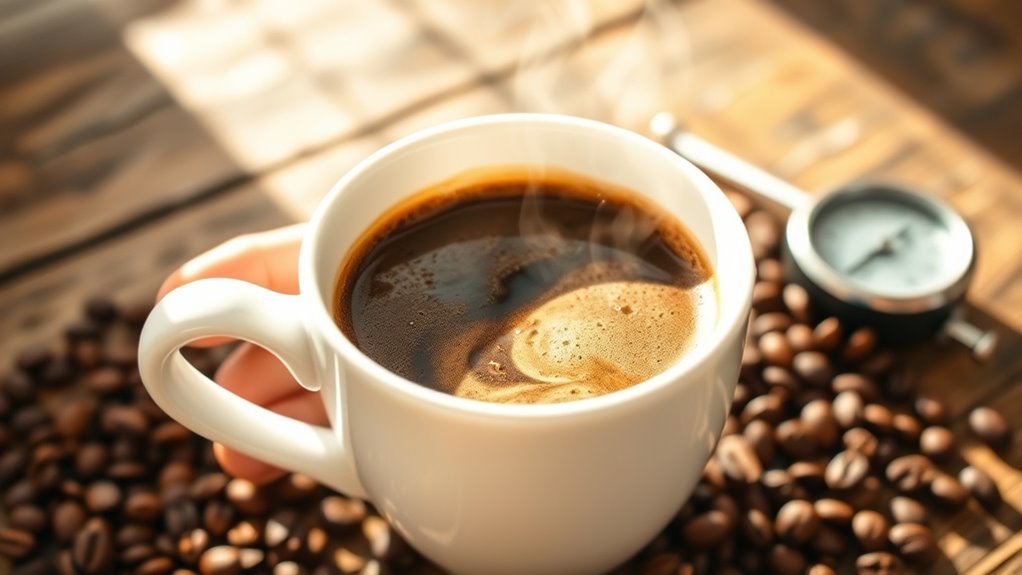
Understanding the science behind flavor extraction can significantly enhance your coffee experience.
Flavor extraction occurs as you dissolve coffee solubles into water, influenced by grind size and water temperature. Initially, acids and fats are extracted, followed by sugars, and finally plant fibers. This sequence affects your brew's flavor balance and intensity. The ideal brew temperature plays a crucial role in maximizing the extraction of these flavors.
Higher Total Dissolved Solids (TDS) lead to a stronger taste, so monitoring TDS helps you achieve optimal flavor.
Different brewing methods, like espresso or pour-over, create unique extraction profiles based on contact time and water flow. Experimenting with grind size, water quality, and extraction time allows you to fine-tune your brew, ensuring a rich and well-rounded coffee that caters to your personal preferences. Additionally, the color accuracy of your coffee equipment can influence the final taste by affecting how you perceive flavors in your brew.
Effects of Temperature on Coffee Taste

The temperature at which you enjoy your coffee significantly impacts its taste and aroma, influencing your overall experience.
The temperature of your coffee shapes its taste and aroma, profoundly affecting your enjoyment.
At temperatures below 122°F (50°C), bitterness decreases, while aromas become less noticeable. However, when you sip coffee at around 140-158°F (60-70°C), you'll experience stronger roasted, earthy flavors. Additionally, it's interesting to note that sugar content can also affect the perception of sweetness in beverages. Studies show that HEPA filter vacuums can help maintain a clean environment, enhancing the overall coffee experience.
Bitterness peaks at about 132°F (56°C), but the sweetness shines best around 111°F (44°C). As your coffee cools, you'll likely discover more intricate flavor notes emerging.
The most complex flavors, including fruity and floral notes, become apparent between 31-37°C. Ultimately, experimenting with different temperatures can help you unlock the full potential of your coffee, enhancing your enjoyment and sensory experience. Additionally, understanding how coffee consumption varies across cultures can provide insights into preferred brewing methods and flavor profiles.
Ideal Brewing Temperatures for Different Roasts
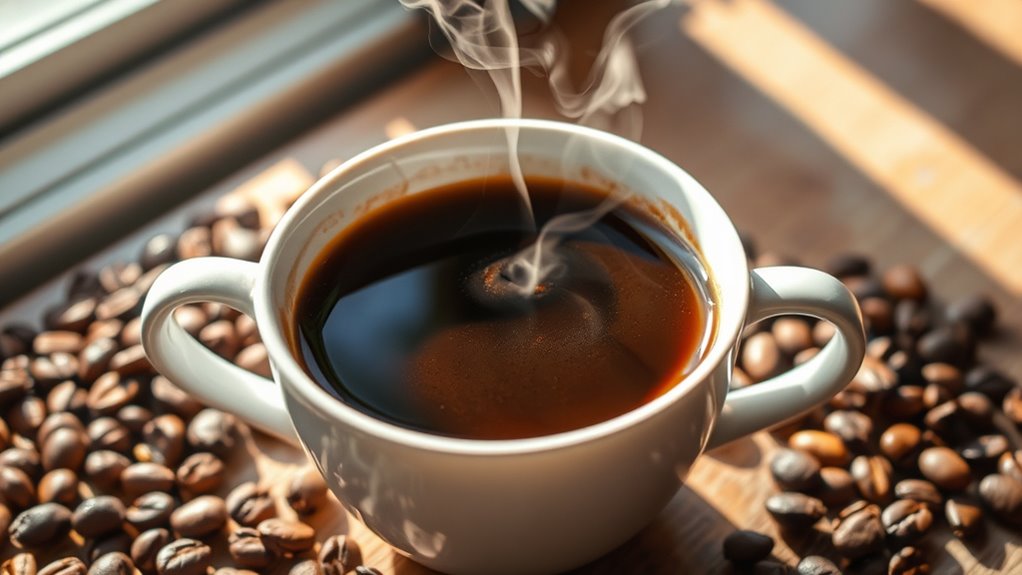
Brewing coffee at the right temperature can make all the difference in flavor, especially when it comes to different roast types.
For light roasts, aim for around 205°F (96°C). Higher temperatures help unlock those complex flavors, as these denser coffees benefit from thorough extraction, similar to the importance of tracking income for managing a budget effectively. Maintaining a clean brewing environment can also enhance the flavors and overall experience, as regular home cleaning supports a healthier lifestyle.
If you're brewing dark roasts, lower the temperature to about 195°F (90°C) to prevent bitterness and maintain smoothness.
Medium roasts fall in between; around 203°F (95°C) works well.
Remember, your brewing method also plays a role—pour-over techniques often require higher temperatures for even extraction.
Don't hesitate to experiment a bit; finding the perfect temperature tailored to your taste can elevate your coffee experience significantly. Additionally, enjoying your coffee alongside a frozen yogurt can enhance the overall indulgence of your treat.
Optimal Drinking Temperature for Coffee

Have you ever wondered what the perfect drinking temperature for your coffee is? Most coffee lovers enjoy their brew best between 125°F and 155°F (51–68°C).
At around 140-158°F (60-70°C), you'll experience rich, roasted flavors. However, temperatures above 155°F can mask those subtle notes and risk burning your tongue. Many sustainable coffee brands focus on optimizing the coffee experience by ensuring quality beans are sourced responsibly, enhancing both flavor and ethical consumption. Additionally, natural elements in your environment, such as calming colors and textures, can elevate your coffee enjoyment experience.
As your coffee cools, you'll notice an increase in sweetness and acidity, while bitterness tends to fade. To enhance your experience, let your coffee cool a bit before sipping.
Experimenting with different temperatures can reveal exciting flavor dimensions, so don't hesitate to try your brew at various degrees. Finding your sweet spot can make all the difference in your coffee enjoyment! Additionally, understanding how NLP enhances customer interactions can parallel your quest for the perfect brew, as both are about refining personal preferences.
Research Insights on Coffee Temperature Preferences

Many coffee enthusiasts are curious about how temperature influences their drinking experience.
Research from the UC Davis Coffee Center shows that most consumers prefer their coffee between 58 and 66°C, with the sweet spot landing around 68.3°C. They used a five-point Just About Right scale, gathering data from 118 participants tasting 27 samples, resulting in over 3,000 data points.
Interestingly, temperature had little effect on flavor perception but did influence purchase intent, peaking at 64°C. Effective location scouting can be crucial for optimizing coffee tasting environments, as different regions may favor varying temperatures. Additionally, consuming coffee at the ideal temperature can enhance its health benefits, such as improving cognitive function and mood. Drinking coffee at the right temperature can also help maximize its antioxidant properties, which are essential for overall health.
Ultimately, serving coffee at a comfortable temperature ensures both enjoyment and safety, enhancing your overall experience.
Equipment for Precise Temperature Control
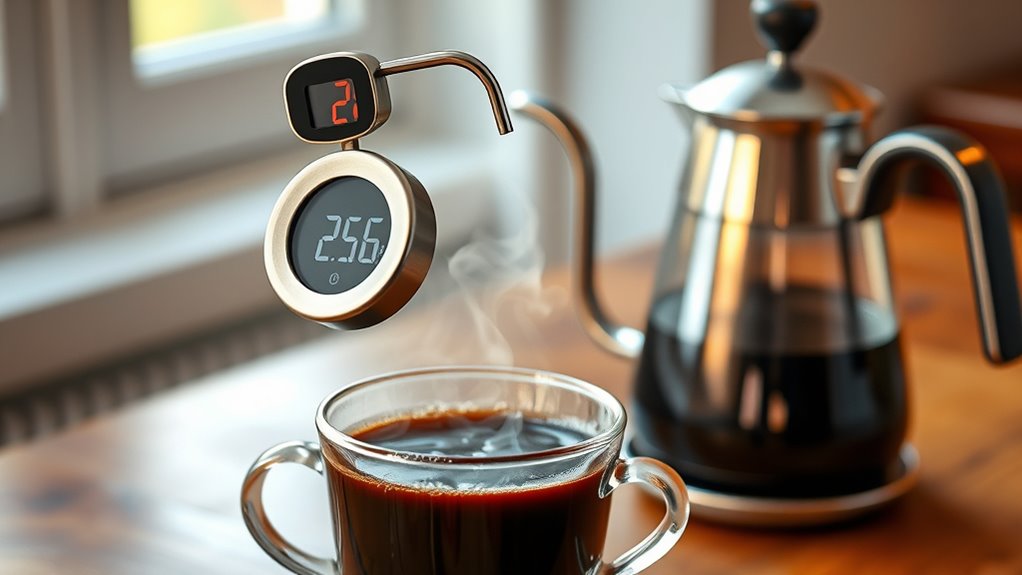
To enjoy the perfect cup of coffee, investing in equipment that ensures precise temperature control is essential.
Advanced coffee machines feature temperature control systems with sensors that monitor and adjust water temperature for optimal brewing. These sensors help maintain consistent temperatures, using heating elements like plates or coils. Control panels let you set and adjust brewing temperatures manually or automatically. Some models also include HEPA filtration systems that can remove any airborne particles that might affect the brewing environment. Additionally, many airless paint sprayers are designed for versatile applications, making them suitable for various projects beyond just painting.
Advanced coffee machines ensure optimal brewing with precise temperature control systems and user-friendly control panels for perfect coffee every time.
Precision brewing devices utilize intelligent temperature control, allowing for exact adjustments during brewing.
Some machines incorporate sub-boilers for stable water temperatures, while combined valve assemblies enable separate hot and cold water injection.
With PID control systems and built-in thermometers, modern machines make it easier than ever to achieve the ideal temperature for your coffee, ensuring a consistently flavorful experience. Additionally, selecting appliances with Energy Star ratings can further enhance your coffee experience by promoting energy efficiency in your kitchen.
Personal Preferences in Coffee Temperature

What temperature do you prefer for your coffee? Your ideal sipping range likely falls between 58°C and 66°C, but personal taste varies widely.
You might enjoy your coffee hotter in winter or prefer it cooler during warmer months. Interestingly, age can influence your preference, with older individuals tending to favor hotter brews.
Cultural background also plays a role—different regions have unique customs that affect how coffee is enjoyed.
Remember, taste is subjective; what's perfect for you mightn't work for someone else. You may find that your coffee's flavor and aroma change with temperature, highlighting sweetness when cooler or bitterness when hotter. Additionally, nutrient diversity can enhance your overall coffee experience, especially when enjoyed with a balanced breakfast.
Ultimately, it's about finding the balance that satisfies your palate.
Experimenting With Brewing Methods
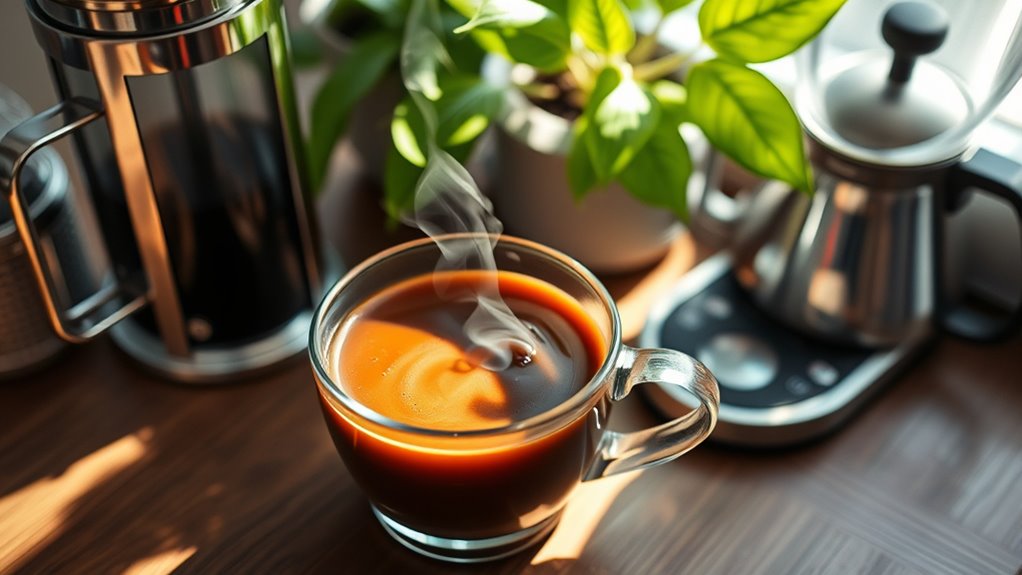
While exploring the world of coffee brewing, you'll discover that each method offers unique characteristics that can elevate your coffee experience.
For instance, pour-over techniques grant you control over variables like water temperature and coffee-to-water ratio, perfect for highlighting the subtle flavors in lighter roasts.
If you're after a rich, full-bodied brew, try the French press, which uses a coarse grind and a steeping time of 3-4 minutes.
Espresso brewing requires finely ground coffee and high pressure, delivering intense flavors in a concentrated shot.
The AeroPress combines immersion and percolation, allowing for versatile flavor profiles.
Finally, auto-drip machines simplify the process, producing consistent coffee ideal for convenience.
Each method invites experimentation to find your perfect brew.
Tips for Achieving the Perfect Cup

Achieving the perfect cup of coffee starts with a few essential tips that can significantly enhance your brewing experience.
First, choose quality coffee beans—opt for 100% Arabica for richer flavors. Pay attention to roast levels, as light and medium roasts preserve subtle notes.
Select high-quality 100% Arabica coffee beans and choose light or medium roasts to enjoy their intricate flavors.
Next, grind your beans appropriately; use a coarse grind for French press and fine for espresso.
Remember the ideal brewing temperature is between 195°F and 205°F—let boiling water cool for 30-60 seconds.
Use a standard coffee-to-water ratio of 2 tablespoons per 6 ounces, adjusting to your taste.
Lastly, ensure your water is filtered to avoid impurities, which can negatively impact flavor.
Following these tips will help you brew a consistently delicious cup.
Frequently Asked Questions
Can I Brew Coffee at a Lower Temperature for Health Benefits?
Yes, you can brew coffee at a lower temperature for health benefits.
By using lower brewing temperatures, you reduce acidity, making it easier on your stomach and potentially minimizing digestive issues.
Cold brew is a great option, steeping coffee grounds in cold water for 12-24 hours. It retains antioxidants and can even have higher caffeine content.
Experimenting with different temperatures can help you find a brew that suits your taste and health needs.
How Does Altitude Affect Coffee Brewing Temperature?
Altitude affects coffee brewing temperature by lowering the boiling point of water due to reduced atmospheric pressure.
As you ascend, water boils at a lower temperature, which can lead to under-extraction if you don't adjust your brewing methods.
To counter this, you can use a finer grind and extend your brew time.
Staying mindful of these factors ensures you still get the rich flavors you desire, even at higher elevations.
Does the Type of Water Impact Brewing Temperature?
The type of water you use doesn't directly impact brewing temperature, but it can affect your coffee's flavor and extraction.
If your water's hard, with high mineral content, you might experience over-extraction. Conversely, soft water can lead to under-extraction.
It's important to maintain consistent water temperature for optimal brewing, regardless of water type, so focus on quality to enhance your coffee experience while keeping your brewing temperature steady.
What Is the Best Way to Cool Down Brewed Coffee?
Did you know that cold brew coffee is typically brewed at room temperature, around 68-72°F?
To cool down your brewed coffee quickly, try adding ice cubes or placing it in the refrigerator.
If you want to avoid dilution, frozen coffee cubes are a great option.
Another method is pouring hot coffee over ice, which preserves flavors while cooling.
Experiment with these techniques to find your preferred temperature!
How Long Should I Wait After Brewing Before Drinking?
After brewing, you should wait about 5 to 7 minutes before sipping your coffee.
This cooling period allows the flavors to develop and balance, enhancing your overall experience.
If you've brewed a lighter roast, consider waiting a bit longer to let it degas properly.
Drinking too soon can mask the coffee's true taste, so patience pays off for a better cup.
Enjoy the process and find what works best for your palate!
Conclusion
As you sip your perfectly brewed coffee, savor the rich aroma and nuanced flavors that dance on your palate. By mastering the art of temperature control, you elevate your experience from ordinary to extraordinary. Remember, each roast deserves its own ideal temperature, transforming a simple cup into a symphony of taste. So, embrace your preferences, experiment with methods, and let every warm sip wrap you in a cozy embrace, igniting your passion for the perfect brew.
